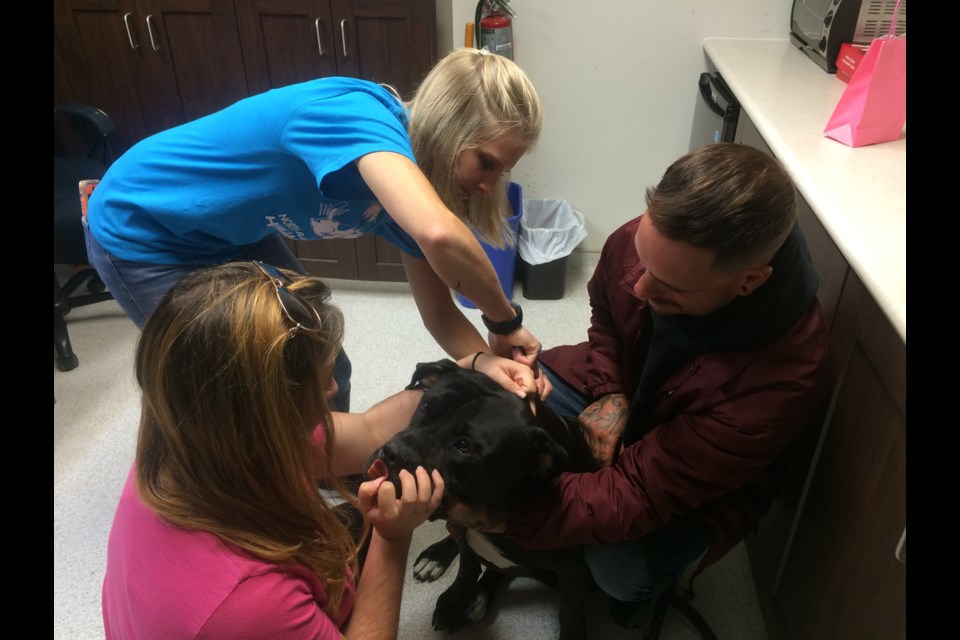Bribed with a few treats Rosa, a 15-month-old South African Boerboel sits quietly unaware that she was about to get microchipped.
The procedure was done and over within a matter of seconds before Rosa even knew what happened.
Owner Matt Gauthier feels secure knowing should she become lost and brought to a shelter or veterinarian’s office as the microchip has contact information that will help to reunite the pair.
“She has a tendency to walk off sometimes and we just wanted to make sure we could find her if she did wander off.”
Gauthier took advantage of Barkfest microchip day, hosted by the North Bay & District Humane Society.
Dog and cat owners were encouraged to have their pet microchipped as a permanent form of identification.
Jeff Twain brought his dog to the clinic after witnessing someone trying to take his pet.
“It was important for me to get this done. I love my dog. She’s my world.”
Having his puppy microchipped gave Abraham Kingsbury peace of mind.
“I did it because I don’t have to worry about him. He’s just full of energy. If he ever ran away, I know the information is there.”
The Humane Society has been offering the clinic for several years with great response.
As Dr. Ron Schweitzer explains it is a quick and painless procedure which involves inserting a small piece of technology the size of a grain of rice between the shoulder blades.
“It is strictly a hypodermic injection under the skin. It is a large needle, but we put it in a spot where the dog or cat tend to react quite well to it. It is always put in the same spot which is between the shoulder blades so anyone checking for a chip knows where to look,” explained Schweitzer.
“The whole point of the microchip system is that all the shelters, all the animal control agents in the townships, all the veterinary clinics are equipped with scanners and the knowledge to scan the animals for chips and hopefully find an owner quicker than it would otherwise be possible.”
Liam Cullen executive director of the North Bay and District Humane Society says it is the first thing the humane society looks for when a lost dog or cat comes through its doors.
Cullen shared the remarkable story of a family reunited with its long-lost cat due to the technology.
“We had a pet that had been lost last August, actually around this time last year. It had been lost for five months and somebody brought it to our organization. It was lost in Mattawa, and it was located at the gas station just outside of Corbeil on the road,” shared Cullen.
“The family was actually moving from Ottawa to Sudbury and the cat had gotten out of their vehicle in Mattawa. We scanned it looking for the microchip. They had updated their new address in Sudbury, and we were able to locate them and reunite them after five long months. So that is just one of the great stories about why it is important to microchip your pets.”
It is not unheard of, especially at this time of year when people are vacationing with their pet, or they leave it with a pet sitter, that an animal has gone off on its own.
“When we do the microchipping, we provide everybody with the information to contact the microchipping company so if ever they do move, or update their email address or their phone number, they can contact the company and make those updates,” said Cullen.
It can also provide vital information including diet, how it behaves around other animals and if its vaccinations are up to date.
“It is sort of like a medical alert bracelet for pets. You can store medical information as well in the microchip or of course, with the microchip company. So, if ever the pet does come to us, and we scan it and find out that it does have a medical issue, that does help us as well.”
Microchipping is a one-time service.



